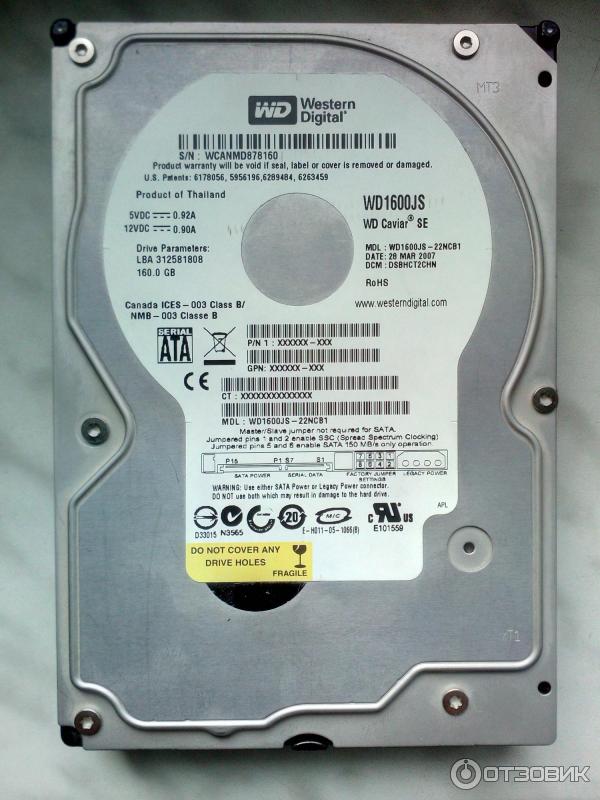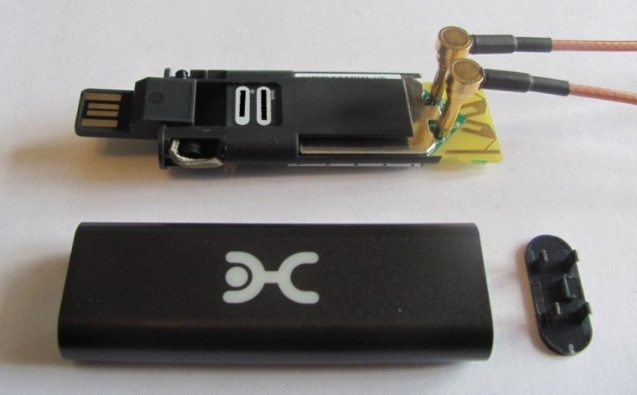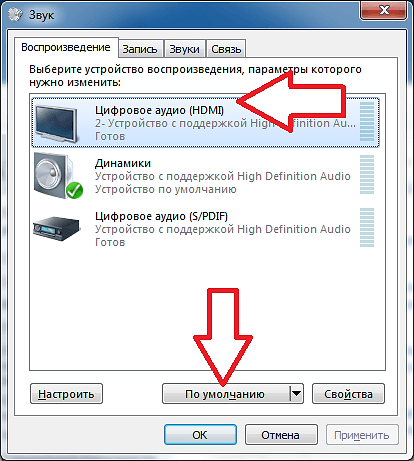The genuine file is a software component of Intel® Rapid Storage Technology (RST) by Intel Corporation .
This Windows service is the primary executable module of the Intel® Rapid Storage Technology (RST) Service, providing the interface between the Windows OS and the firmware drivers and specific chipsets that implement Intel® Matrix RAID (Redundant Array of Inexpensive Disks) technology. Until 2009, the Intel® Matrix Storage Manager was classified as a software application. After version 9.5 it was renamed as «RST» and considered a driver. Intel is constantly releasing new versions of RST which include new RAID-related features, but new features may require specific hardware to support them. Intel Corporation, in Santa Clara, CA, USA, was founded in 1968 by two Fairchild engineers and is now the world’s largest and highest-valued semiconductor manufacturer.
The .exe extension on a filename indicates an exe cutable file. Executable files may, in some cases, harm your computer. Therefore, please read below to decide for yourself whether the IAStorDataMgrSvc.exe on your computer is a Trojan that you should remove, or whether it is a file belonging to the Windows operating system or to a trusted application.
IAStorDataMgrSvc.exe file information
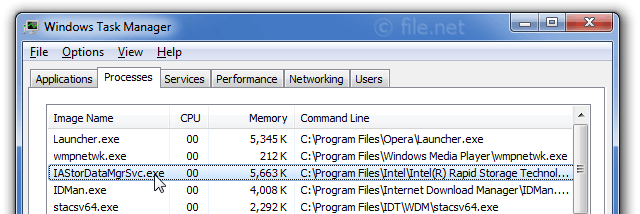
IAStorDataMgrSvc.exe process in Windows Task Manager
Description: IAStorDataMgrSvc.exe is not essential for Windows and will often cause problems. IAStorDataMgrSvc.exe is located in a subfolder of «C:Program Files (x86)» or sometimes in a subfolder of the user’s profile folder —primarily C:Program Files (x86)IntelIntel(R) Rapid Storage Technology. Known file sizes on Windows 10/8/7/XP are 13,336 bytes (31% of all occurrences), 13,592 bytes and 28 more variants .
It is a background process, and the service name is IAStorDataMgrSvc. The service provides storage event notification and manages communication between the storage driver and user space applications.
The program has no visible window. It is a Verisign signed file. It is certified by a trustworthy company. IAStorDataMgrSvc.exe is not a Windows system file. IAStorDataMgrSvc.exe appears to be a compressed file. Therefore the technical security rating is 27% dangerous, however you should also read the user reviews.
Important: Some malware camouflages itself as IAStorDataMgrSvc.exe. Therefore, you should check the IAStorDataMgrSvc.exe process on your PC to see if it is a threat. We recommend Security Task Manager for verifying your computer’s security. This was one of the Top Download Picks of The Washington Post and PC World.
Score
User Comments
Summary: Average user rating of IAStorDataMgrSvc.exe: based on 38 votes with 21 user comments. 3 users think IAStorDataMgrSvc.exe is essential for Windows or an installed application. 6 users think it’s probably harmless. 15 users think it’s neither essential nor dangerous. 11 users suspect danger. 3 users think IAStorDataMgrSvc.exe is dangerous and recommend removing it. 3 users don’t grade IAStorDataMgrSvc.exe («not sure about it»).
Best practices for resolving IAStorDataMgrSvc issues
A clean and tidy computer is the key requirement for avoiding problems with IAStorDataMgrSvc. This means running a scan for malware, cleaning your hard drive using 1 cleanmgr and 2 sfc /scannow, 3 uninstalling programs that you no longer need, checking for Autostart programs (using 4 msconfig) and enabling Windows’ 5 Automatic Update. Always remember to perform periodic backups, or at least to set restore points.
Заметки Лёвика
web программирование, администрирование и всякая всячина, которая может оказаться полезной
- Главная
- О сайте
IAStorDataMgrSvc.exe грузит процессор
Ноутбук Sony Vaio стал подтормаживать, причем иногда непосредственно сразу после перезагрузки. И окончание загрузки всех программ не приводило к улучшению.
Диспетчер задач сразу выдал причину. При этом жесткий диск не тормозил, а замедление работы было из-за нагрузки на процессор. В этот раз грузил процессор не Svchost, а некий IAStorDataMgrSvc.exe на целых 25%. Судя по графикам, нагрузка была на одно ядро.

Что такое IAStorDataMgrSvc.exe?
Это EXE файл, связанный со службой Intel (R) Rapid Storage Technology. Расположение по умолчанию
%PROGRAMFILES%IntelIntel(R) Rapid Storage Technology
Никаких вирусов в файле не обнаружено, файл от “производителя”.
Технология Intel® Rapid Storage позволяет достичь такого уровня производительности, быстродействия и масштабируемости, как никогда ранее. Для любого количества используемых дисков Serial ATA (SATA) ощутимо увеличивается производительность и снижается энергопотребление за счет использования новейших накопителей SATA.
Есть подозрение, что эта служба создаёт повышенную нагрузку на процессор при “несовместимых” (”неправильных”, “кривых”) драйверах.
Как решить пробему с IAStorDataMgrSvc.exe и повышенной нагрузкой
Поскольку с заявленными задачами ускорения производительности в данной ситуации эта служба не справляется, а более того тормозит работу компьютера, Intel Rapid Storage вместе с IAStorDataMgrSvc.exe можно удалить (через пункт установка и удаление программ)
Можно ли восстановить корректную работу IAStorDataMgrSvc.exe — сложно сказать.
- В BIOS нужно проверить, установку диска SATA в режим AHCI, а не на IDE.
- Использовать предыдущую версию драйверов для Intel (R) Rapid Storage Technology (в одной из обновлённых версий драйвера обнаружены проблемы совместимости).
- Собственно отключить автозагрузку IAStorDataMgrSvc.exe (Пуск — Панель управления — администрирование — службы, найти Службу Intel (R) Rapid Storage Technology — переключить в выпадающем меню вместо Автозапуск Вручную)
UPD. В моём случае помогла установка драйвера Intel® Rapid Storage Technology (RAID) версии 12.9.0.1001. (при том, что установлена была более поздняя.. если не ошибаюсь, 12.9.4…). Всё работает:

Метки: vaio
Опубликовано Четверг, Август 29, 2013 в 15:38 в следующих категориях: Без рубрики. Вы можете подписаться на комментарии к этому сообщению через RSS 2.0. Вы можете оставить комментарий. Пинг отключен.
Автор будет признателен, если Вы поделитесь ссылкой на статью, которая Вам помогла:
BB-код (для вставки на форум)
html-код (для вставки в ЖЖ, WP, blogger и на страницы сайта)
ссылка (для отправки по почте)
Комментарии (3) к записи “IAStorDataMgrSvc.exe грузит процессор”
- Димка сообщает Август 28th, 2015 в 11:35:
Установите .NET Framework 4.5
Была та же проблем с перегрузом процессора при не запущеных программах. Установлена .NET Framework 4.6.1, подошла к ней только Intel Rapid 11.7.0.1013 и после чего процессор заработал нормально
У меня iastordatamgrsvc стал грузить процессор, периодически выдавая ошибки о том, что диск повреждён — Ошибка диска на порте. Сбрасывал диск в нормальное состояние, работа восстанавливалась.
IAStorDataMgrSvc.exe грузит процессор на ноутбуке
Опции темы
- Версия для печати
- Отправить по электронной почте…
- Подписаться на эту тему…
Отображение
- Линейный вид
- Комбинированный вид
- Древовидный вид
Старожил 



IAStorDataMgrSvc.exe грузит процессор на ноутбуке
В ноутбуках порой бывают зависания, и обследование диспетчера задач показывает, что IAStorDataMgrSvc.exe грузит процессор, чуть ли не на 100%. Некоторые сразу впадают в панику, и подозревают вирус, что совсем неудивительно. Порой именно вирусы прячутся под полезные исполнительные файлы exe. А вдруг это не вирус? Что такое IAStorDataMgrSvc.exe, и как отличить его от вируса, мы сейчас и посмотрим.
IAStorDataMgrSvc.exe — что это за процесс
iastordatamgrsvc, что это такое? Это один из файлов приложения Intel® Rapid Storage, и полностью расшифровывается как IA Storage Data Manager Service. То есть, это менеджер, отвечающий за свою область деятельности. По задумке Intel® Rapid Storage, этот менеджер должен обеспечивать быстродействие системы, отвечать за формирование кэша, и т. д.
Очевидно, если процесс IAStorDataMgrSvc.exe отнимает все ресурсы процессора, значит, тут что-то не так. Прежде всего, нужно убедиться, что это и правда не вирус. Зайдите в свои установленные «Программы и компоненты», и посмотрите, есть ли у вас программа Intel Rapid Storage. Если программа есть, тогда процесс IAStorDataMgrSvc.exe не вирус, он просто работает неправильно.
Ну а если вы не отыскали Intel Rapid Storage, срочно зовите на помощь Д. Веба, или Касперского. Не будем обсуждать антивирусные программы, а вернёмся к IAStorDataMgrSvc.exe, и постараемся понять, почему этот процесс грузит процессор, и как это исправить.
Почему IAStorDataMgrSvc.exe грузит процессор
Почему процесс IAStorDataMgrSvc.exe грузит процессор, если по идее производителя он должен разгружать процессор и оптимизировать запуск приложений? Такое может случиться, если:
1. Вирус повредил Intel® Rapid Storage, и процесс IAStorDataMgrSvc.exe не может запуститься нормально. Может, это даже не вирус, а ваш собственный антивирус, который что-то неправильно понял, и удалил часть нужных файлов.
2. Процесс может неправильно работать, если на нём повреждены/устарели драйвера.
3. Возможно, пользователь сам по неосторожности удалил часть ПО, в связи с чем менеджер грузит процессор по полной программе, но не может выполнять то, ради чего он и был создан.
Он снова и снова пытается запуститься, но из-за повреждений не может этого сделать. Есть несколько вариантов решения проблем, как снять нагрузку на процессор.
Как снять нагрузку на процессор
Первым делом нужно перезагрузить компьютер. Порой простой перезапуск помогает решить многие проблемы. Если же процесс IAStorDataMgrSvc.exe по-прежнему грузит процессор, нужно думать, как это исправить.
Отключите процесс через диспетчер задач, и удалите его из автозапуска, если он там присутствует. Попробуйте поработать немного за компьютером, и понаблюдать, не появится ли он снова.
Если после очередного запуска системы процесс появился снова и опять начал грузить систему, можно его удалить. Нужный файл находится по адресу C:Program Files (x86)IntelIntel(R) Rapid Storage Technology. Это не файл Виндовс, и его удаление никак не повлияет на саму ОС.
Не хотите удалять пока? Ну ладно, просто переименуйте файл, добавив точку или лишний дефис в имени файла, и он перестанет запускаться.
Это не решение проблемы, но по крайней мер, процесс перестанет грузить процессор. Чтобы действительно решить проблему, нужно последовательно заняться починкой системы:
Проверка антивирусом и сканирование системы никогда не повредит. В Виндовс есть прекрасное средство диагностики, для поиска и исправления неисправностей. Запустите диагностику и немного подождите. Возможно, Windows сможет обнаружить проблему, исправить её, или порекомендовать решение.
Если система не нашла проблем, принудительно обновите драйвера, и не только для Intel® Rapid Storage. Причиной конфликта могут выступать и другие программы или устройства.
Установите все последние обновления Виндовс, если они есть. Если и это не помогло, придётся удалять Intel® Rapid Storage. Зайдите в Программы и компоненты, и удалите программу, следуя инструкции по удалению. После удаления перезагрузите компьютер, и можете снова установить программу Intel® Rapid Storage, если она вам нужна. Программа Intel® Rapid Storage сертифицирована, и довольно надёжная, и всё же, её польза слишком сомнительна.
How to Fix IAStorDataSvc High CPU Usage
Have you noticed the process IAStorDataSvc running in Windows 10? If yes, then you must have also noticed that this process is eating up a lot of CPU usage. We have received many reports from our users who recently upgraded their computers from Windows 7 or Windows 8/8.1 to Windows 10 and noticed a background process IAStorDataMgrSvc.exe using a lot of CPU resources. This process is commonly known as “IAStorDataSvc.” What is this process? Why is it consuming high CPU and how to fix it? We have all the answers to your questions. Let’s start with the first question.
What is IAStorDataSvc
IAStorDataMgrSvc.exe is the process and IAStorDataSvc is the name of the service which in general terms known as Intel Storage Data Service. This service is used by Intel Rapid Storage Technology, and comes, by default, installed in almost every modern computer. The process is not a virus or a malware. Its job is to provide faster access to frequently used programs, applications, and files by saving them to SSD (if it is present on your computer). The process’ enables the user to use both HDD and SSD. Also, the DSA (Dynamic Storage Accelerator) feature of Intel Rapid Storage Technology adjusts power policies of your computer, and this helps in boosting the SSD’s performance from 10% to 15%.
So, one thing is clear that it is not a malware or a virus. And, you shouldn’t be deleting it from your computer. But, the use of this process mainly comes into picture if the system is being used in an Enterprise and Server scenario. So, if you are a home user, there’s no harm in uninstalling it, as the SSD’s are themselves pretty fast. Also, if there is no SSD on your computer, then you have no use of it. It’s completely your decision to keep it or remove it.
How to Stop IAStorDataSvc from Causing High CPU Usage
The process shouldn’t cause any issues and is supposed to simply run in the background. Some users have reported that the unusual behavior of this process is mostly due to a malware or a virus. Keeping that in mind, use these methods to fix the issue with IAStorDataSvc.
1. Scan for Virus, Malware and/or Malicious Program
As I have mentioned above, there are chances of this process being infected, it is best to first scan your system for virus, malware or malicious program. Just open the antivirus software installed on your computer and run a scan. Many of us no more use an antivirus as Windows 10 comes with Windows Defender. So, if you don’t have an antivirus, open Windows Defender and scan your computer for viruses. If there are any virus, malware or malicious program on your computer then immediately remove them.
2. Reinstall Intel Rapid Storage Technology
After using the first method and making sure that the program is not infected, check if the problem is still present. If it is the case, then you should try reinstalling the software.
Step 1. Press Win key logo + R to open Run. Type appwiz.cpl and click OK. This will open Programs and Features.
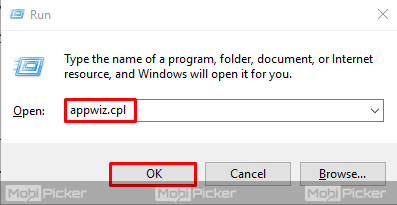
Step 2. Look for the program Intel Rapid Storage Technology. Click on it and select Uninstall. This will install the program on your computer.
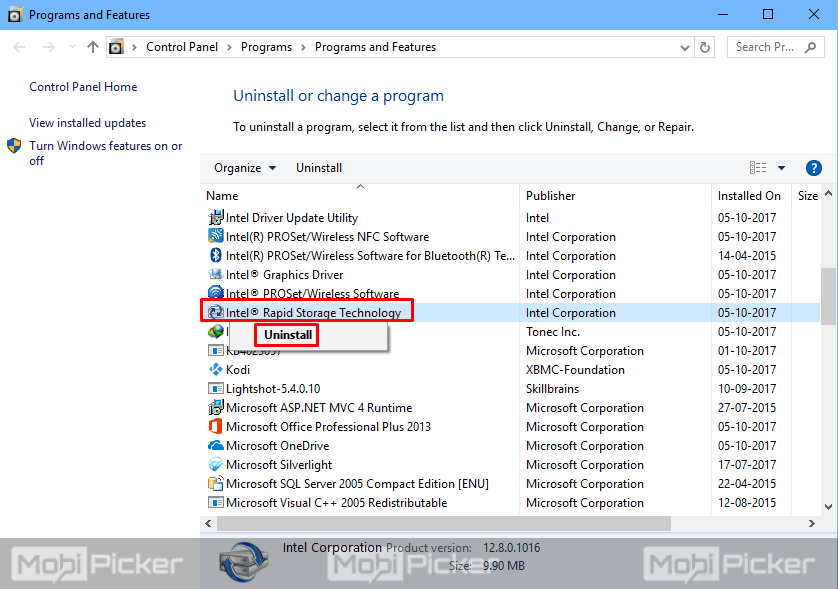
Step 3. Restart your computer.
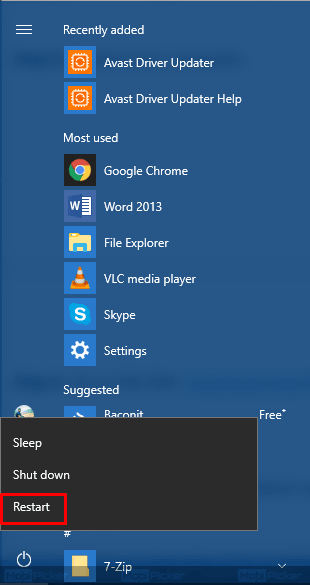
Step 4. Go to this link – Intel Rapid Storage Technology.
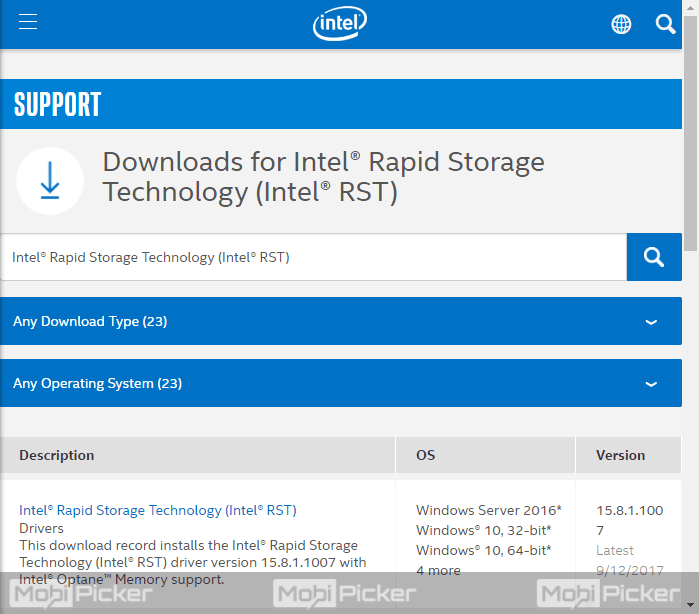
Step 4. Find the latest version of the program and open it. Now, download the SetupRST.exe file.
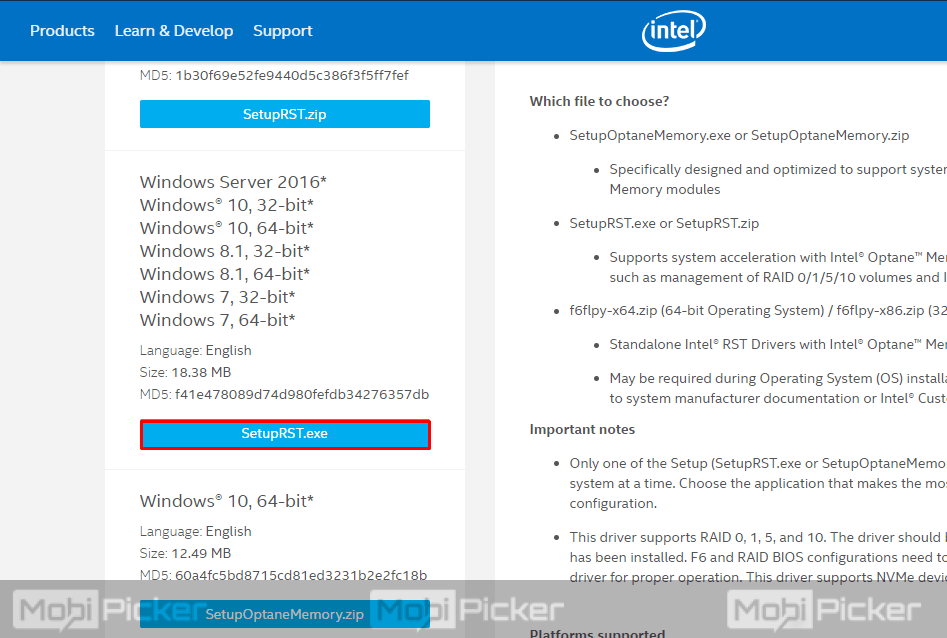
Step 5. Open the downloaded file and install the program. After installing it, restart your computer and check if the program is still using a lot of CPU memory.
If the problem still persists, follow the next method.
3. Remove Intel Rapid Storage Technology
If reinstalling the program didn’t solve the issue, then you might have to uninstall the program if it is bothering you a lot. Also, SSDs on computers are still very new, and many of us don’t have it on our computers. If the program is of no use to you, or you have decided to remove IAStorDataSvc as it’s eating too much CPU, then follow these steps.
Step 1. To remove the program, you need to open Programs and Features. Press Win key logo + R to open Run. Type appwiz.cpl into it and click OK.

Step 2. Find the program Intel Rapid Storage Technology and click on it. Select Uninstall to remove the program from your computer.

4. Disable the Process
If reinstalling the program didn’t work and you cannot make your mind to either remove it or keep it, you can simply disable it for the time being.
Step 1. Press Win key logo + R to open Run. Type services.msc and click OK.
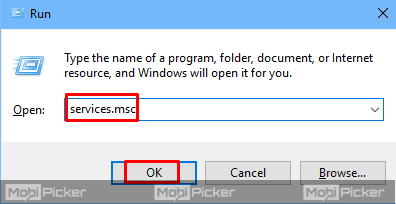
Step 2. Here, you need to find Intel Rapid Storage Technology. To find it quickly, press “I” and look for the process name. Now, double-click on it.
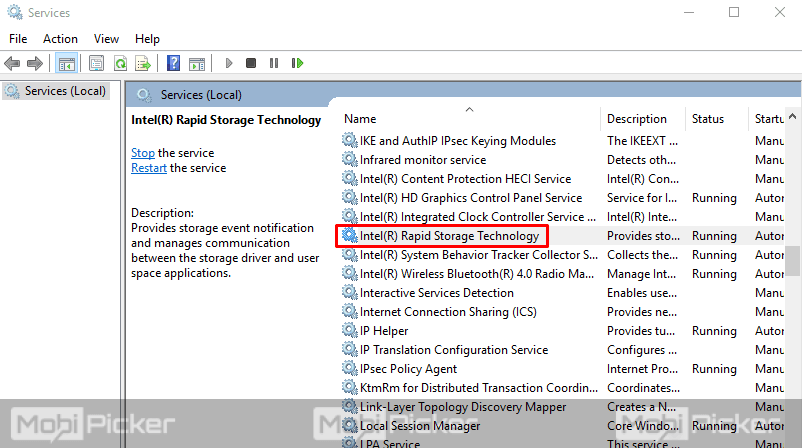
Step 3. The last step will open the program’s properties. Here, you need to change the Startup type. Find it and select it as Disabled from the drop-down menu. Now, click Apply and then OK.
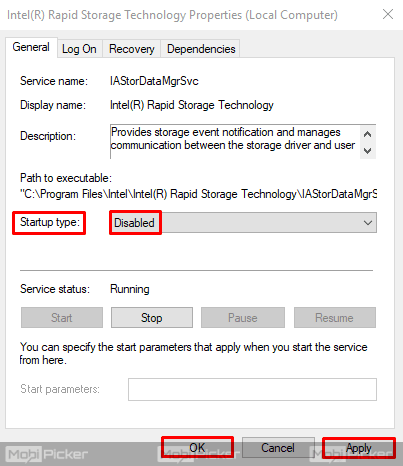
Conclusion
Windows 10 comes with many new features, programs, and processes. Most of these are very useful, but sometimes they are known to cause issues on our computers. IAStorDataSvc can cause high CPU usage in Windows 10, and it is very important to fix this issue. We hope we were able to help you solve this problem. If there any questions regarding the methods to fix IAStorDataSvc high CPU usage in Windows 10, please ask us in comments.
How to Fix: IAStorDataMgrSvc High CPU Usage
![]()
Infopackets Reader Ian S. writes:
Recently I noticed through Task Manager that I have very high CPU usage, even with the computer idle. I looked at Task Manager and it says that ‘IAStorDataMgrSvc’ is eating 25% of my CPU constantly. I read that this is an Intel program and that my computer’s BIOS may not be set up properly, which is causing the problem. I also read that if I set the BIOS improperly (in order to correct the issue), my computer may get stuck in a blue screen loop. I am afraid to make any changes for fear that it may screw something up. Can you help? «
I have not had this problem before, so I asked Ian if he would like me to connect to his machine using my remote desktop support service to have a closer look, and he agreed.
After a bit of research, I discovered that «IAStorDataMgrSvc» is a Windows service for «Intel(R) Rapid Storage Technology», which manages SATA and RAID configurations. In other words, it’s a driver for hard drives that use the Intel chipset (which is usually part of the motherboard). Most of the time this program is not needed, though Intel suggests it is used to optimize I/O (input output), which means that it can improve load times of applications and the operating system itself.
That said, it is not a critical program and is safe to remove from the Windows startup — instructions to follow further down.
Upgrading Intel(R) Rapid Storage Technology May Fix the Issue
It’s worth noting that whenever a program has high CPU usage, it’s often due to a corrupt program installation or configuration inside of Windows (but not always). If you install the latest edition of Intel(R) Rapid Storage Technology, this may very well resolve the issue, and therefore fix the high CPU usage. You can download Intel(R) Rapid Storage Technology from Intel’s website — but please be careful to select the appropriate version as per your operating system.
IAStorDataMgrSvc and the BIOS: Improper Configuration
In Rob’s original question, he mentioned that his BIOS may not be set properly, which is causing the high CPU usage with the IAStorDataMgrSvc service. From what I read online, this may be true. Inside the computer’s BIOS there is a menu for specifying SATA configurations (video), which allows you to set the SATA ports as: SATA, AHCI, IDE, or RAID configuration.
For the most part, users will want to use AHCI (if the option is available) inside the BIOS, as this is most compatible with SSD drives. If AHCI is not available, then use SATA. Also note that some machines, such as Dell may have this labeled as «Normal» or «Legacy» mode — in this case, you would want «Normal». If you are specifically setting up a RAID with two or more drives, then you would specify RAID.
IMPORTANT: please note that before you change the SATA configuration in the BIOS, you will need to go to Windows Devce Manager and install the appropriate SATA / AHCI / RAID driver(s), otherwise Windows will not boot and likely produce a blue screen. Also, for peace of mind, I suggest making a disk image backup of the system before applying any changes, just in case something goes terribly wrong.
With that said, let’s look at an example:
If you are using Windows 10 and the SATA configuration is currently set for IDE and you want to change it to AHCI or RAID, you will need to boot the computer in IDE mode (as it was originally) and then go into Device Manager -> Action -> Add Legacy Hardware -> Install the hardware that I manually select from a list (Advanced) -> (Show All Devices) -> Next -> Have Disk, then specify the path for your AHCI / RAID / SATA driver and let the driver install.
Once this is done, reboot, go into BIOS, change the SATA configuration to AHCI, save changes and reboot, and Windows should now boot in AHCI mode. At this point, the «IAStorDataMgrSvc» in Task Manager should no longer be an issue — if it is, you may want to upgrade the Intel(R) Rapid Storage Technology.
You can watch a Youtube video here which shows how to go into the BIOS and change the SATA to AHCI mode.
If all of what I mentioned above is too much hassle, you may simply want to disable service, described next.
Disabling the IAStorDataMgrSvc Service
Since we know that the IAStorDataMgrSvc Service isn’t a critical service, it can also be disabled. One way to do this is using the Windows Services snap-in.
- Click Start, then type in «services.msc» (no quotes); wait for «Services» or «service.msc» to appear in the list, then click it.
- The «Services» window will appear; scroll down the list until you see «Intel(R) Rapid Storage Technology», then double click it.
- A new window with the title: «Intel(R) Rapid Storage Technology Properties (Local Computer)» will appear. Under the heading «Service Status», click the «Stop» button. Then, where it says «Startup Type», set the option to «Disabled», then click «Apply» and «OK».
At this point, the IAStorDataMgrSvc service will have stopped and will not launch at startup again.
If you still have issues with the IAStorDataMgrSvc service, you are welcome to contact me for 1-on-1 support, described next.
Additional 1-on-1 Support: From Dennis
If this article is over your head, or if you’re still having issues with the IAStorDataMgrSvc service eating your CPU, you are welcome to contact me for remote desktop support, where I can fix this problem for you. Simply send me an email, briefly describing your issue and I will get back to you as soon as possible.
Got a Computer Question or Problem? Ask Dennis!
I need more computer questions. If you have a computer question — or even a computer problem that needs fixing — please email me with your question so that I can write more articles like this one. I can’t promise I’ll respond to all the messages I receive (depending on the volume), but I’ll do my best.

